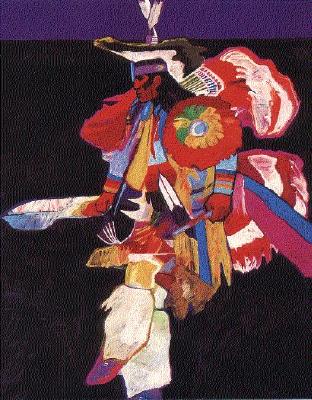|
|
|
|
Dance Champ Lights Up Eyes of Grandmother
by Dorreen Yellow Bird Grandforks Herald Staff Writer
Northern Fancy Dancer by John Nieto
 There is
a joy to having grandchildren. That joy isn't just because we can avoid changing diapers, walking the floor with
a screaming teething child, or stomping our feet because the teen used up all his cleanest dirty shirts, and now
is using his jeans as carpet. The grandchildren are the trophies and the prizes of our battle years, our good and
bad times. The satisfaction is thinking we did something right with their parents. There is
a joy to having grandchildren. That joy isn't just because we can avoid changing diapers, walking the floor with
a screaming teething child, or stomping our feet because the teen used up all his cleanest dirty shirts, and now
is using his jeans as carpet. The grandchildren are the trophies and the prizes of our battle years, our good and
bad times. The satisfaction is thinking we did something right with their parents.When I was a young mother, I worked full-time and cared for three children. I knew that they didn't always get enough of my time and even less of my energy. So when I look at them and see that they are wonderful adults, I know they have more spirit than I gave them and they passed that spirit on to their children. So when a grandmother called me a few days ago to tell me about her grandson, I listened. I understood the pride Joy Schroeder felt for her grandson. Her grandson set some records -- no Olympic records, but world records among Native American nations. Gerimiah Giles Holy Bull, who is 16, is a world champion teen fancy dancer. He won that honor twice. Most recently he carried away that trophy for a world champion fancy dancer at the Schemitzun powwow on the Mashantucket Pequot reservation at Hartford, Conn. He won his first championship in 1993, when he was 7 years old in Bismarck at the United Tribes Technical College international powwow. What is fancy dancing and how does it compare to events such as the Olympics? It is one of the most vigorous and demanding dance trials in Native life, and surely compares with track and field trials. There are three main dances in the Plains area. The first is "traditional," which is slower and danced with dignity. Sometimes it is a story or imitating an animal or spirit. The regalia is usually a bustle worn on the lower back. The second Native American dancer is the "grass dancer" who has no bustles, but yarn, string or cloth strips along his pants and shirt. They have a traditional story of their beginning. Finally the most colorful, the fastest moving and the most demanding is the "fancy dance." Holy Bull's regalia is similar to other outfits. He told me he helped his father, Greg Holy Bull, a UND professor, put together his fancy dance outfit. All regalia are handmade either by the family or a Native person at the request of the family. Gerimiah's outfit is two large bustles -- one on the lower back and one of the upper back. The colors (red, orange, yellow, white and blue) were given to him by his father. They are sacred colors for his use. The bustles are tipped with flagging tape, hackles of white, yellow, orange and red (hackles are small fluffy feathers) and are on a turkey spike -- a feather from wing of a turkey. Gerimiah and most of the Native dancers wear a roach for head gear -- that is a strip of long deer hair worn across the top of the head. A photograph of Gerimiah in his dance regalia is hanging in the I-29 Cafe. Holy Bull said his father, Greg, helped him learn the dance steps, but he added his own style to the dance as he grew more confident. Gerimiah is Cheyenne River Lakota Sioux and Turtle Mountain Chippewa. He lives with his mother, Diane Schroeder, in Grand Forks. Schroeder is a student at UND. My grandmother would say "nawah" to this young man who walks in two cultures, and well in both. She would sit beside his grandmother who is so proud of her grandson, and feel that pride, too. Yellow Bird's e-mail address is dyellowbird@gfherald.com or she can be reached at (701) 780-1228. |
|
|
| Canku Ota is a free Newsletter celebrating Native America, its traditions and accomplishments . We do not provide subscriber or visitor names to anyone. Some articles presented in Canku Ota may contain copyright material. We have received appropriate permissions for republishing any articles. Material appearing here is distributed without profit or monetary gain to those who have expressed an interest. This is in accordance with Title 17 U.S.C. section 107. |
|
Canku Ota is a copyright of Vicki Lockard and Paul Barry. |
|
The "Canku Ota - A Newsletter Celebrating Native America"
web site and its design is the Copyright © 1999 of Paul C. Barry. |